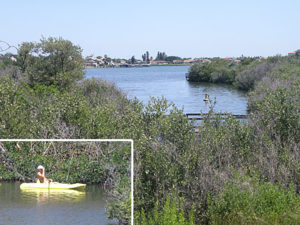
New SWIM Leader Will VanGelder started life as the black sheep in a high-achieving family. His father, a Korean War veteran, was a dean at the University of Florida when he grew up in Gainesville. But instead of following that academic tradition, he often found himself deciding between getting to school on time or following a nearby creek through the woods.
“I learned a lot in the woods,” he says, nearly 40 years after having earned degrees from the University of Florida and Florida International University. As the new director of the Southwest Florida Water Management District’s Surface Water Improvement and Management (SWIM) program, VanGelder is taking that love for the outdoors to the next level.
“My dad wasn’t sure about my getting my first UF degree in natural resource conservation because he wasn’t sure it was an ‘employable’ degree,” he recalls. “Then it took me eight years to get a master’s at FIU because I was working for my professor and as a field technician helping to build and maintain research team access in remote areas of the Everglades.”

Those years in the woods and the wetlands instilled a deep respect for the diversity of Florida’s natural lands and the beauties of each – a trait which will serve the region well as SWIM looks beyond Tampa Bay’s watershed and begins to focus on lands to the north that provide much of our potable water.
Established in 1987 by the Florida Legislature, the SWIM program’s first priority was Tampa Bay. Many of the most spectacular preserves in the region – from thousands of acres at Terra Ceia and Rock Ponds on the bay’s eastern shore to Clam Bayou in urban Gulfport – were designed and built by SWIM engineers and project managers, typically in partnership with local governments.
As most of the coast is either developed or restored, the challenge for local land managers now is sea level rise. Scientists already are looking upstream – including a long-term outline for 73,300 acres along the Little Manatee River. “We’re also going to be looking past expensive publicly owned land and reaching out to landowners,” VanGelder said. “There are many people who are dedicated to conservation in the private sector, we just need to broach the subject.”

Conservation easements, for instance, allow farmers to continue to run their agricultural businesses while selling development rights to ensure that the land will not be transformed into houses and shopping centers. Working with the state’s Rural and Family Lands Protection Program, VanGelder is accessing potential properties against the District’s core missions including flood control, water supply, water quality and protecting and maintaining natural systems.
“The biggest challenge facing us is building natural systems that will still be functioning after 20 to 50 years,” he said. “To a certain degree, we’re already doing that, but when natural systems hit a man-made barrier we’re going to have a problem.”
Along with the Tampa Bay watershed, SWIM’s new priorities have extended both to the north and south, with 12 priority water bodies including Rainbow River, Crystal River/Kings Bay, Lake Panasoffkee, Charlotte Harbor, Lake Tarpon, Lake Thonotosassa, Winter Haven Chain of Lakes, Sarasota Bay, Weeki Wachee River, Chassahowitzka River and Homosassa River.
“We go in, evaluate water quality, identify potential issues and implement the most cost-effective projects to restore both water quality and habitat in critical watersheds,” he said.
In the end, VanGelder’s top priority is leaving a state where his two daughters – now 15 and 17 – have the same opportunities that he did growing up in Gainesville. “Yes, there are a lot more people in Florida now, and more moving in every day, but we can manage our heritage with good land ethics and find a way to co-exist to our mutual benefit.”
https://www.swfwmd.state.fl.us/projects/swim
Read more about SWIM projects from previous issues of Bay Soundings
Toxic “hot spot” becomes top priority for restoration, redevelopment, recreation in urban setting
Restoration of Wolf Branch Creek– Fall 2003
[su_divider]